- eISSN 2353-8414
- Tel.: +48 22 846 00 11 wew. 249
- E-mail: minib@ilot.lukasiewicz.gov.pl
Analiza cytowań i współcytowań pojęcia „word of mouth” na podstawie publikacji z zakresu nauk społecznych
Krzysztof Błoński*
University of Szczecin, Institute of Management, Cukrowa Street 8, 71-004, Szczecin, Poland
*E-mail: Krzysztof.blonski@usz.edu.pl
Krzysztof Błoński; ORCID: 0000-0002-1713-625X
DOI: 10.2478/minib-2023-0012
Abstrakt:
„Word of mouth” (WOM) jako narzędzie komunikacji dość znacząco ewoluował w czasie ostatnich kilkudziesięciu lat. Pierwotnie przekaz informacji z ust do ust ograniczał się do lokalnego zasięgu tzn. był ograniczony tylko do najbliższych osób z grona nadawcy komunikatu. Rozwój technologiczny jaki nastąpił w okresie ostatnich trzydziestu lat, a szczególnie technologii komputerowych i mobilnych spowodował znaczące zmiany w tej formie komunikacji. Przekazywane informacje nabrały zasięgu globalnego, konsument może nawiązać bezpośrednią komunikację z przedsiębiorcą. W literaturze przedmiotu można znaleźć przykłady analiz bibliograficznych tylko eWOM bez uwzględnienia tradycyjnego WOM. Dlatego wydaje się istotnym próba przeanalizowania zbioru publikacji dotyczących zarówno WOM jak i eWOM. Celem artykułu jest identyfikacja i przedstawienie najczęściej cytowanych prac (wraz z ich autorami), jak również publikacji do których najczęściej odwołują się autorzy publikujący prace związane z WOM. Do realizowania zakreślonego celu wykorzystano analizę cytowań i analizę współcytowań. Podstawą do analiz jest zbiór publikacji z bazy WoS. Uzyskane wyniki pozwoliły na zidentyfikowanie i stworzenie listy najczęściej cytowanych i współcytowanych publikacji.
MINIB, 2023, Vol. 48, Issue 2
DOI: 10.2478/minib-2023-0012
Str. 111-133
Opublikowano 31 czerwca 2023

Analiza cytowań i współcytowań pojęcia „word of mouth” na podstawie publikacji z zakresu nauk społecznych
Introduction
Nearly 60 years ago, de Solla Price (1965) proposed scientific methods for the study of science (Boyack et al., 2005). The basis in bibliometric methods is bibliographic data from scientific publication databases, through which structural images of areas, scientific fields, can be constructed. The procedure for bibliometric analysis can be encapsulated in the following steps (Donthu et al., 2021a): (1) Defining the objectives and scope of the bibliometric study, (2) Selecting bibliometric analysis techniques, (3) Collecting data for bibliometric analysis and (4) Performing the bibliometric analysis and presenting the results. The two main applications of bibliometric methods are outcome analysis and science mapping (Cobo et al., 2011). Results analysis aims to assess the research and publication results of individuals and institutions. Science mapping, on the other hand, aims to reveal the structure and dynamics of scientific areas. With information on structure and development, it is possible for a researcher to determine the realisation, development or changes in research on a particular topic (Zupic & Cater, 2015).
The use of bibliometric methods has allowed objectivity to be introduced into the evaluation of scientific literature (Garfield, 1979). This is made possible by applying quantitative rigour to the subjective evaluation of the literature. Among bibliometric analysis techniques, a distinction can be made between review, evaluative and relational techniques. Review techniques include structured literature reviews and meta-analyses oriented towards generating knowledge through frequency analysis. Evaluative techniques can be used to identify qualitative and quantitative indicators of research and to compare the scientific contributions of other researchers. They can also identify the number of articles published or the number of citations of individual publications, authors and journals. Relational techniques examine the relationships between data in publications, e.g. topics, methods, co-authorship. They can include the analysis of co-citation, co-occurrence of words, co-authorship of publications, bibliographic links, co-citation clustering or direct citations (Lenart-Gansiniec, 2021).
The primary technique used in bibliometric analysis is citation analysis. It involves measuring the number of citations a paper has received, which enables an overall assessment of its quality (Anderson, 2006). This approach follows the fact that citations are used to determine impact-if an article is frequently cited, it is considered important. This thesis is based on the assumption that authors cite documents that they consider important to their work (Zupic & Cater, 2015).1 Citations also reflect the degree of knowledge transfer and spread by other authors, representing other research centres (Ejdys, 2016). Citation analysis can provide information on the relative impact of publications, but at the same time its disadvantage is that it is not possible to identify networks of interconnectedness between scientists (Usdiken & Pasadeos, 1995)-which can be taken as a rationale for distinguishing other variants of citation analysis that differ in the scope of the data considered. These are (Klinkiewicz et al., 2012):
- Direct citation analysis-construction of a matrix with data reflecting the cases of direct citations of one author’s texts by others;
- Bibliographic coupling analysis-identification of publications that cite the same article, i.e. refer to the same sources of knowledge; this variant of analysis usually makes it possible to identify the most recent publications in a given citation network;
- Co-citation clustering analysis-an indication of which publications, sources of knowledge, are referred to in selected articles, which usually makes it possible to identify the oldest publications in a given citation network;
- Co-citation analysis-covering selected publications and the knowledge sources they cite.
When two items (e.g. documents, journals or authors) are cited in the reference list of the citing item, there is a co-citation relationship between them (Osareh, 1996). Small (1973) presented co-citation analysis to investigate the relationship and structure of academic fields. Subsequently, co-citation analysis has been widely used to reveal the relationship and structure of authors, articles and journals in academic fields. Co-citation analysis uses the number of co-citations to construct measures of similarity between documents, authors or journals. Co-citation is defined as the frequency with which two units are cited together. The basic premise of cocitation analysis is that the more times two items are cited together, the more likely it is that their content is related. Depending on the unit of analysis, a co-citation analysis can be carried out: of documents, authors or journals. It should be noted that co-citation is a dynamic measure. This is because the publication process is time-consuming, and thus the result of a co-citation analysis reflects the state of the field at a given point in the preparation of the publication, and not necessarily what it looks like now (Zupic & Cater, 2015). At a further stage, the data obtained in the cocitation analysis can be used to divide into clusters/clustering (co-citation clustering analysis, co-citation clustering). For this purpose, representative examples of literature items are selected as objects to be analysed, and then a physical division into clusters is made through the network analysis method. The structure and characteristics of a specific field are thus obtained.
A thorough description of the issues surrounding bibliometrics, the characteristics of the other bibliographic techniques indicated earlier and the procedure for bibliometric analysis are presented in publications such as: the studies of Donthu et al. (2021a), Zupic and Cater (2015) and Roemer and Borchardt (2015).
Interest in 'word of mouth’ (WOM, whisper marketing) began in the US in the 1940s in academic circles. Early definitions of WOM appeared in the work of Allport and Postamam (1946) and Zaraket (2020). As research on WOM developed, further definitions of the concept emerged. Examples include the work of Westbrook (1987), Buttle (1998), Stokes et al. (2002) and Litvin et al. (2008), among others. Most often, classic 'word of mouth’ is defined quite broadly as an informal exchange between consumers of positive or negative information about a product or service that is not commercial in nature (Zaraket, 2020). The mentioned transmission of information takes place within the sender’s circle of acquaintances, which implies its local reach. The transfer of knowledge about products or services is usually accompanied by the need for interaction or friendship (Linkiewicz, 2015). This is the result of the WOM mechanism, which is based on the creation of conversational capital (Cesvet et al., 2010; Gawrońska, 2013). It is only revealed in one situation when consumers want to talk to other people about a brand, product or service. The emerging desire to talk to others is justified in the literature by the following factors: (1) the psychological construct of human beings-the need to share opinions with others, which may have a basis in the operation of the instinct of self-preservation, (2) the desire to establish contacts with others and thus accumulate a kind of social capital, (3) economic reasons and (4) the desire to free oneself from the pressures/influence of advertising.
The technological developments we have seen over the last 20–30 years have contributed to changes in the communication environment. The emergence and development of various new online communication channels has led to the emergence of the term electronic word of mouth (eWOM, online whisper marketing). It has been defined as 'any positive or negative message spoken by a potential, current or former customer about a product or company that is shared with many people and institutions on the Internet’ (Hennig-Thurau et al., 2004).
In the marketing field, it is believed that WOM-type communication can significantly influence a consumer’s purchasing decision. Therefore, WOM has been recognised as a highly reliable form of marketing information (Huang et al., 2011). Research results indicate that in addition to influencing the purchase decision (O’Reilly & Marx, 2011), WOM can also affect consumer choice (Richins, 1983), service change (v. Wangenheim & Bayón, 2004) or product/service perception (Sweeney et al., 2014). Whisper marketing also appears as an exogenous or endogenous variable in various estimated models. A review of such models is provided in the work of Kundu and Rajan (2016). Based on a review and analysis of 20 papers, they conclude that WOM strongly influences consumers’ behavioural attitudes. In the literature, we can also find papers on literature review and bibliometric analyses, as well as meta-analyses focussed on eWOM and WOM (e.g. Abbas et al., 2020; Bhaiswar et al., 2021; De Matos & Rossi, 2008; Donthu et al., 2021b; Huete-Alcocer, 2017).
Based on a review of publications on both bibliographic and WOM analyses, it has been assumed that the purpose of the article is to identify and present the most frequently cited works (along with their authors), as well as the publications most often referred to by authors publishing WOMrelated works.
Methodology
It was assumed that the purpose of bibliometric analysis of the concept of WOM is: (1) to identify which works are most often cited in a given research field (mandatory reading list); as well as (2) to identify which publications are most often referred to by published articles. Based on a search of the Web of Science (WoS) database, 8,332 publications were identified, 83% of which were articles (as at March 20, 2023). The above result was obtained by adopting the following publication search criterion: 'word of mouth’ OR 'wom’, included in the publication title and/or keywords and/or abstract. The search for publications was limited to the following categories (as defined by WoS): business, management, tourism and hospitality, communication, economics, social sciences, sociology and psychology. Another restriction applied was the indication of the types of publications to be included in the search: articles, post-conference materials, books, chapters in books and publications in so-called early access. The characteristics of the resulting set of documents are presented in Table 1.
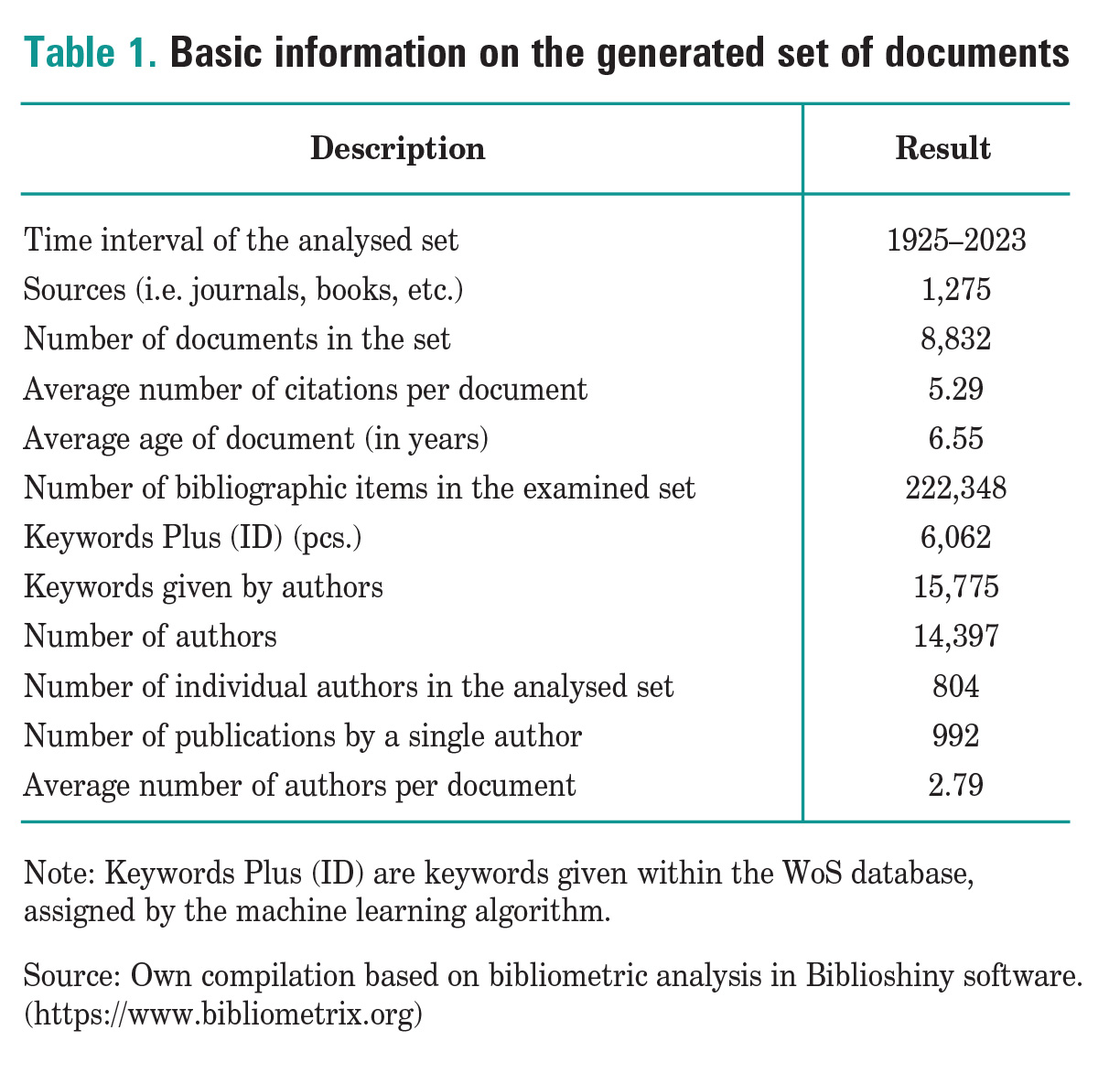
The completeness of the individual fields in the database was then assessed to estimate the quality of the data obtained. For basic document information (i.e. author(s), publication title, etc.), the level of missing responses is at a very low level. The highest level of missingness was observed among the keywords given by the authors, amounting to 979 (i.e. 11%), but this was assessed as acceptable.
It will be possible to achieve the stated objectives by performing citation analysis, co-citation analysis and co-citation clustering analysis on the downloaded dataset. The indicated analyses were performed using VOSviewer (version 1.6.17) and Biblioshiny software (https://www.bibliome trix.org).
The authors of the VOSviewer program are Nees Jan van Eck and Ludo Waltman. The program is based on the visualisation of similarities (VOS) technique, where similarity between objects is used for visualisation (similar objects are located close to each other and less similar objects are located away from each other) (van Eck & Waltman, 2010). The results of the analyses are presented as a network, where each node represents an entity (e.g. article, author, country, institution, keyword, journal), whereby:
- the size of a node indicates the occurrence of a given item (e.g. the number of times a keyword occurs),
- the link between nodes represents the co-occurrence between items (e.g.
keywords that co-occur or occur together), - link thickness indicates the occurrence of co-occurrence between items (the number of times that, for example, keywords co-occur or occur together) – the thicker the link between nodes, the more frequent the occurrence of co-occurrence,
- the larger the node, the more frequent the occurrence of a given item, e.g. a keyword,
- each colour represents a topic cluster, where the nodes and links in this cluster can be used to explain the coverage of the topic (cluster), the topics (nodes) and the relationships (links) between topics (nodes) manifested within this topic (cluster).
Bibliometrix (https://www.bibliometrix.org/home/) and its companion application Biblioshiny run in the R environment. Their aim is to provide a complete set of functions to support the overall bibliomteric analysis, together with the possibilities to visualise the results obtained and prepare a report with selected results of the analyses performed. A detailed description of the capabilities of this software is presented in the study of Aria & Cuccurullo (2017).
Results of Citation and Co-Citation Analysis
The first publication in the WOS database related to WOM was published in 1925. For the following years, the above topic did not arouse the interest of authors and researchers. The beginning of an increased number of publications can be observed in the 1980s, while a jump in the number of publications can be observed from the beginning of the 21st century. Last year, i.e. 2022, 833 new publications were recorded in the WoS database. Figure 1 shows the changes in the number of publications on whisper marketing from 1925 to the present.
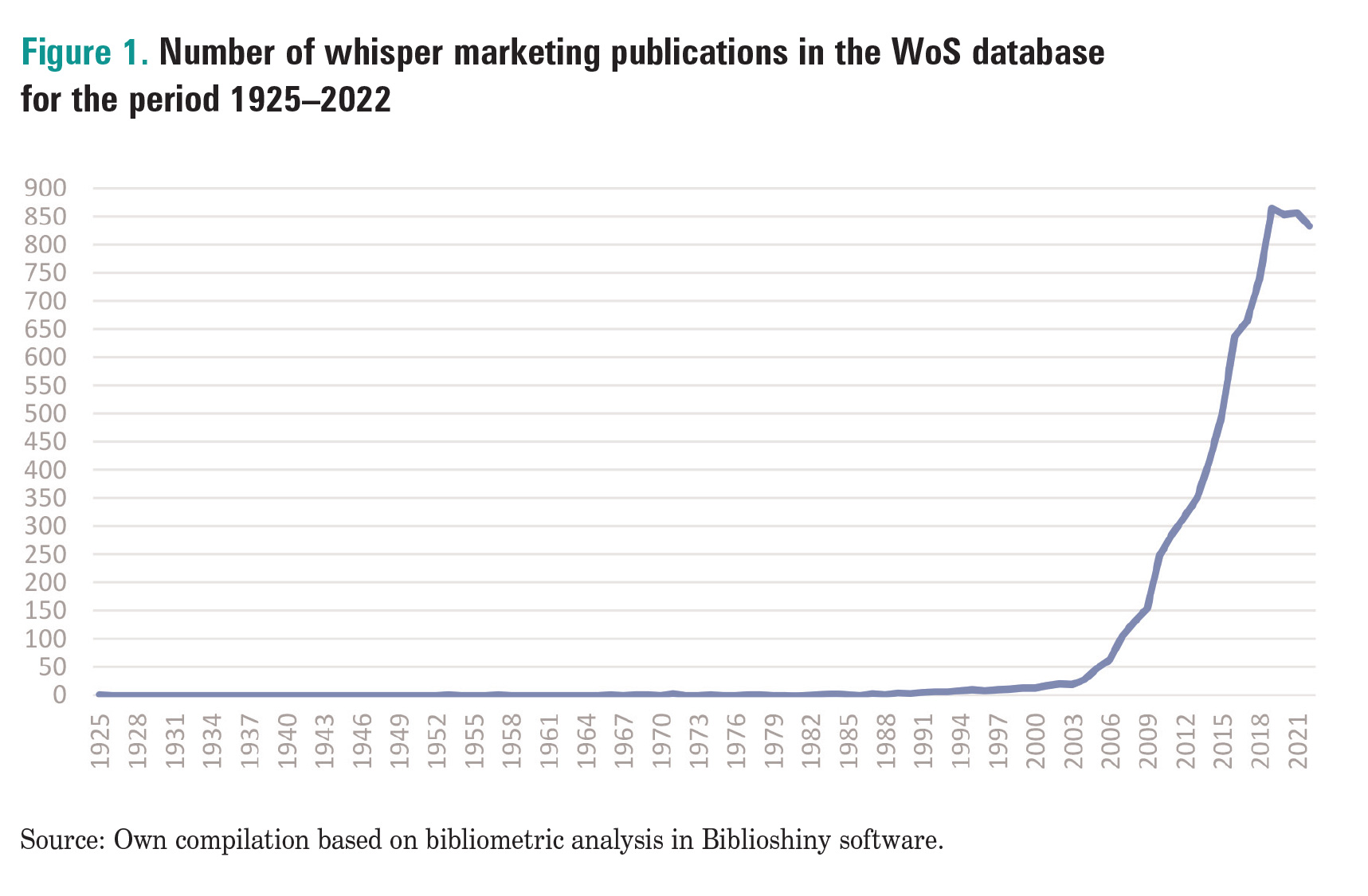
The author with the most publications on whisper marketing is Rob Law with 52 items (as author or co-author), followed by Juran Kim, who has published 41 of them. When it comes to place of publication, it is the Journal of Business Research (320 items) and the Journal of Retailing and Consumer Services (209 items) that have the highest number of articles in this field. A detailed list of the 10 most published authors on a given topic as well as the 10 most frequent publication places is presented in Table 2.
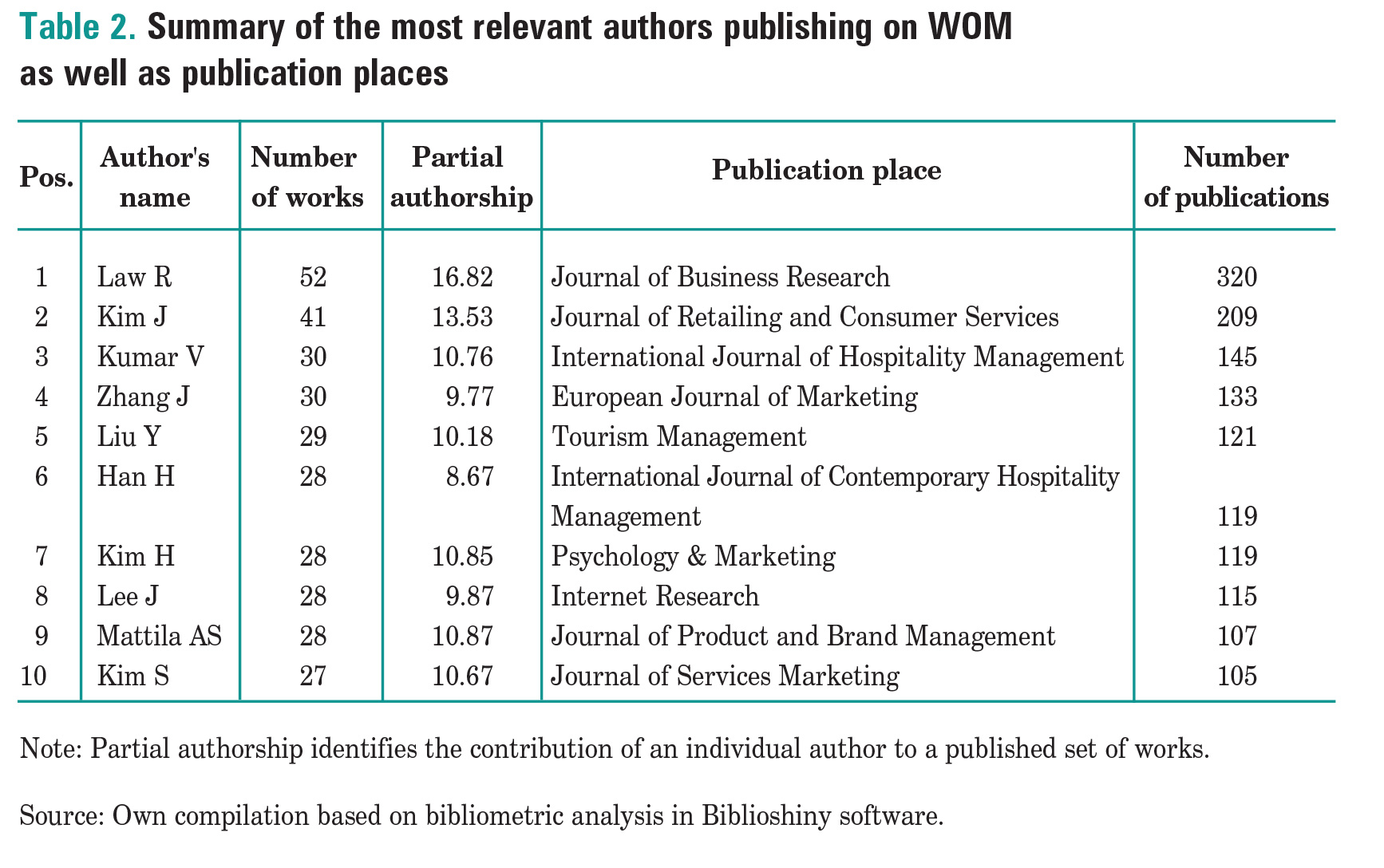
The resulting picture is completed by graphing the average citations of published works. An analysis of the average number of citations in individual years reveals an increased interest in this area in particular years, as well as its variability. Recent years have been characterised by a decreasing interest in the addressed issues (Figure 2).
Another summary obtained was the ranking of the most cited works and their authors. The ranking can be made on the basis of citations from the entire database (so-called global citations, global citations) as well as from the generated set of documents (so-called local citations). The difference between the results in the two sets and the position may be a result of the fact that for many documents a large proportion of the global citations may come from other disciplines. In the analysed set in the first and second cases, the most cited paper is the article by Chevalier, J. A., and Mayzlin, D., from 2006, entitled: The effect of word of mouth on sales: Online book reviews. In it, the authors present the results of their research on the importance of consumer reviews for book sales at two online bookstores, i.e. Amazon.com and BarnesandNoble.com.
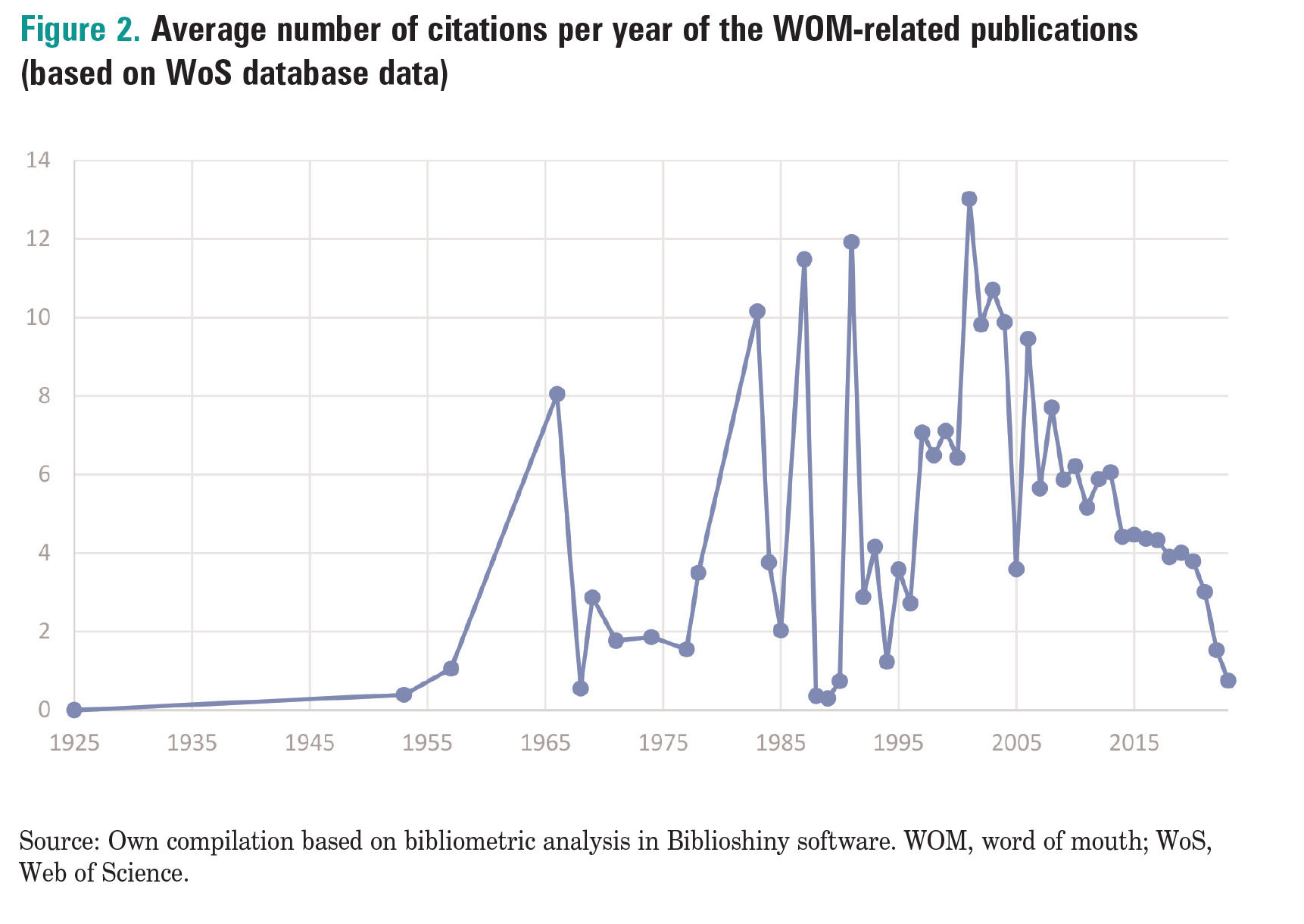
They conclude that customer WOM has a causal effect on consumer buying behaviour at both online bookstores i.e. an improvement in book reviews leads to an increase in relative sales at that site. Furthermore, they note that the impact of onestar (negative) reviews is greater than the impact of five-star (positive) reviews. The second most cited paper in the entire database is an article written by a team of authors (Van Doorn, J., Lemon, K. N., Mittal, V., Nass, S., Pick, D., Pirner, P. and Verhoef, P. C.) in 2010, entitled Customer engagement behavior: Theoretical foundations and research directions and published in Journal of service research. In the article, the authors focussed on 'customer engagement behaviours’ (CEBs), which they defined as expressions of customer behaviour towards a brand or company, beyond purchase, driven by motivation. According to the authors, CEBs encompass a wide range of behaviours, including WOM-type activity, recommendations, helping other customers, blogging, writing reviews and even engaging in legal activities.
In the case of so-called local citations, the second most cited item is a 2004 article by Godes and Mayzlin (2004), entitled Using online conversations to study word-of-mouth communication and published in the journal 'Marketing science’. The authors of the article highlighted significant challenges in measuring WOM. A summary of the most frequently cited papers, so-called global citations and local citations, is presented in Table 3.
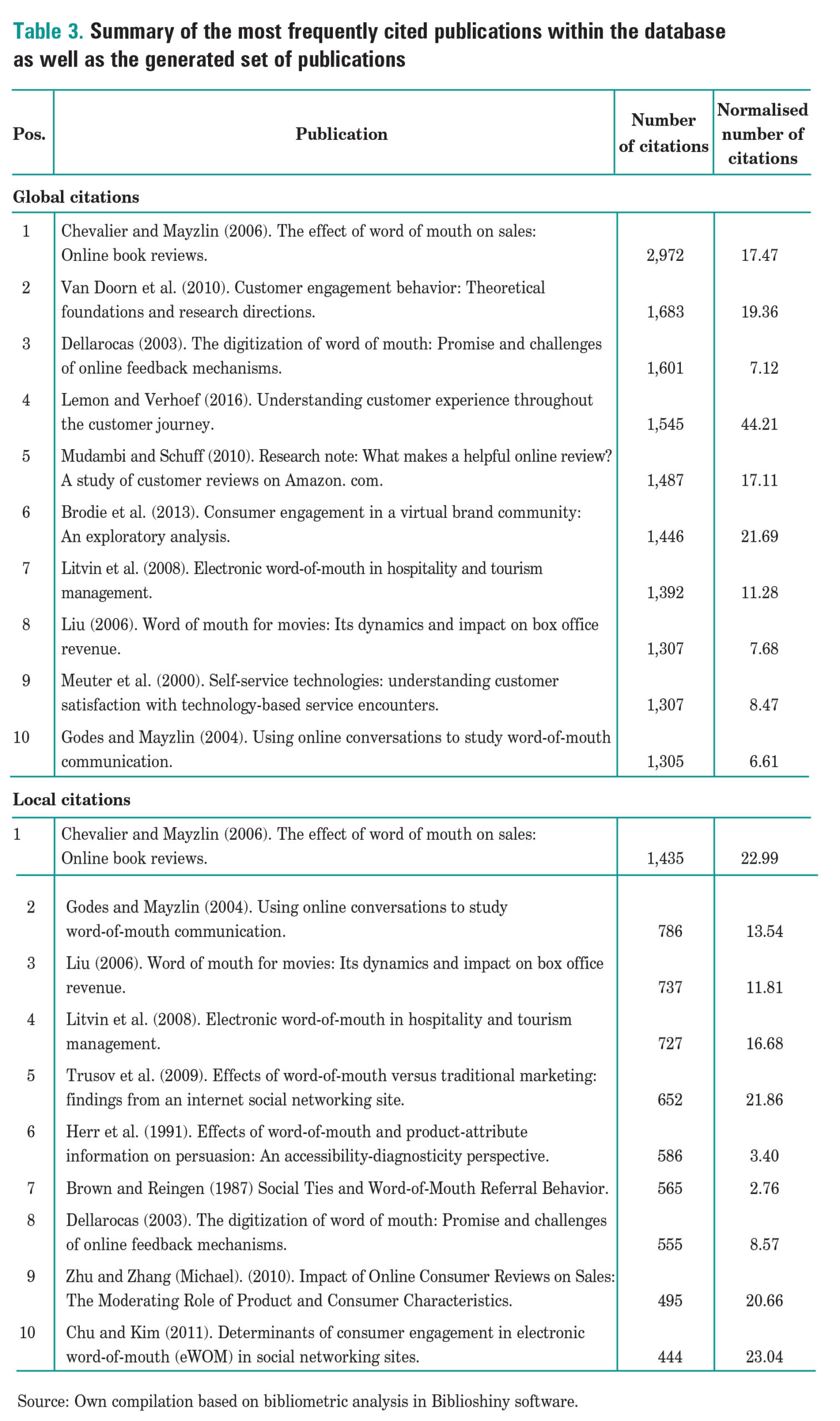
Co-citation analysis makes it possible to determine the frequency with which two items are cited together, i.e. a co-citation relationship is formed between them. In the case of the set of publications analysed, the 10 most frequently co-cited items of literature are presented in Figure 3. This allows the identification of publications (selected using citation thresholds) considered important by the researchers citing them (Zupic & Cater, 2015).
The first is an article by Fornell and Larcker (1981) entitled 'Evaluating Structural Equation Models with Unobservable Variables and Measurement Error’ published in 1981 in the Journal of Marketing Research. It addresses the issue of evaluating the quality of the resulting structural model. In the case of the set of publications under discussion, the appearance of this item is due to the use of this method for modelling the phenomenon under study.
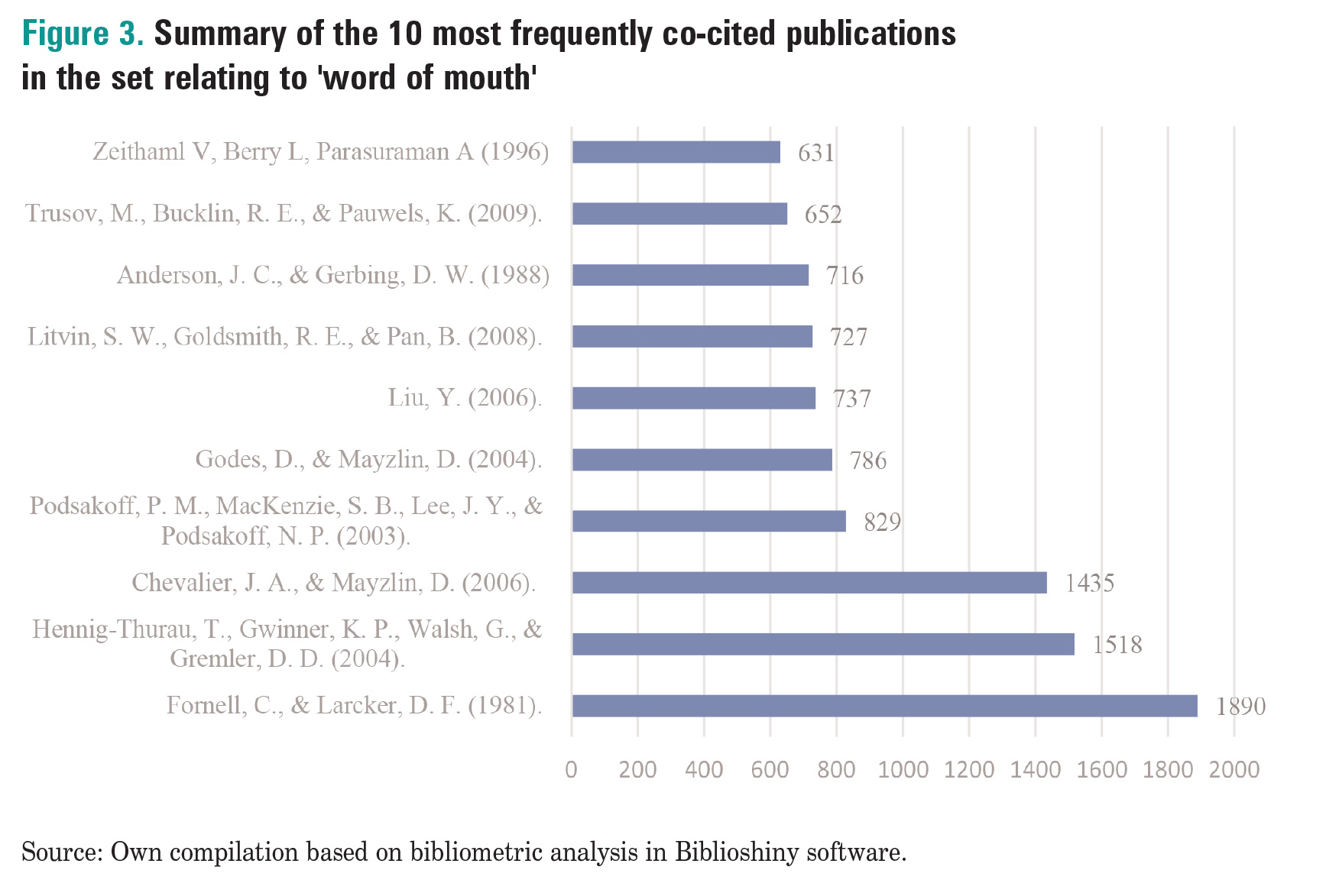
The same situation will also apply to keyword analysis, where there will also be words associated with structural modelling. Another item is an article published by four authors (Hennig-Thurau, T., Gwinner, K. P., Walsh, G. and Gremler, D. D.) in 2004 and entitled: Electronic word-of-mouth via consumer-opinion platforms: what motivates consumers to articulate themselves on the internet?. The authors, basing themselves on the results of research on virtual communities and the traditional WOM literature, developed a typology of motives for opinion articulation by consumers online. Using an online sample of 2,000 consumers, they generated information on the structure and importance of consumers’ motives for articulating opinions online. The results indicate that the desire for social interaction, the desire for economic incentives, concern for other consumers and the opportunity to increase one’s self-esteem are the main factors leading to eWOM behaviour. The third most frequently co-cited item is the aforementioned publication by Chevalier and Mayzlin (2006), entitled: The effect of word of mouth on sales: Online book reviews.
At a further stage, the identified literature items were divided into clusters/clustering. The division was carried out using the VOSviewer software. As there were more than 200,000 citations in the sample, it is not possible to perform a co-citation analysis for the whole sample. McCain (1990) suggested that a cut-off point could be established to select the most influential papers. Therefore, items that were cited at least 200 times were selected for this study. Figure 4 highlights the most relevant co-cited pairs. The size of the node represents the normalised number of citations received by the articles and the thickness of the line represents the strength of the cocitation relationships. The line and proximity between two articles identify the co-citation relationships between them. The colour of the node indicates the cluster with which the article is associated. Each node was labelled by the first author and the year of the article’s publication. In the figure shown, there are 112 nodes, 6,260 links and 3 clusters. Due to the large number of papers in each cluster, only leading papers will be presented.
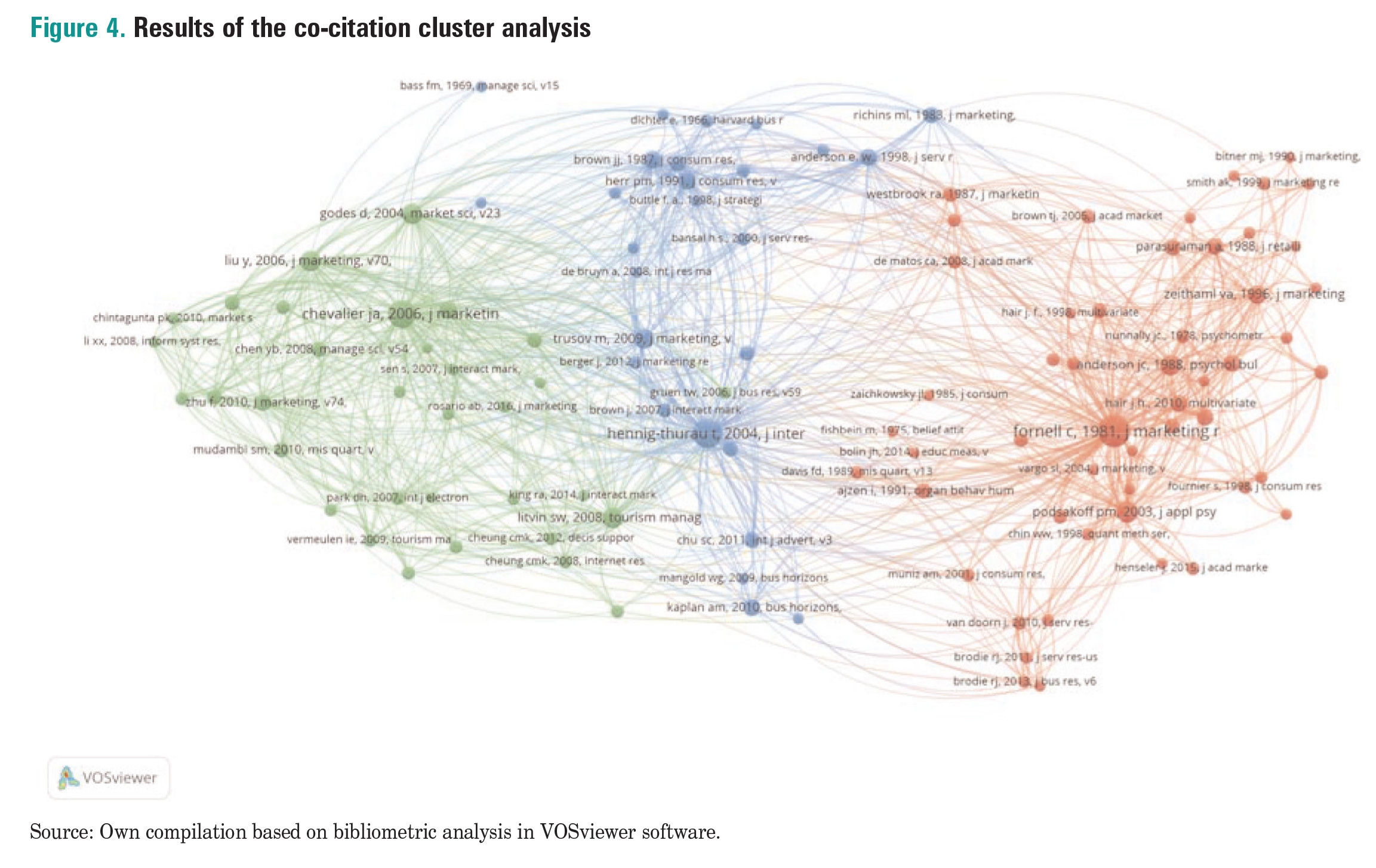
The first largest set (red) contains 52 items. The central part is taken up by a publication by Fornell and Larcker (1981).2 For example, it is co-cited with another item from the previously presented list of publications (i.e. Podsakoff et al., 2003) 509 times. Another item from this set is a paper by Anderson and Gerbing (1988) on structural modelling. Given the examples cited, it can be assumed that this set can be identified with the widely understood methodology of WOM research.
The second largest set (green) contains 33 items. The article by Chevalier and Mazylin (2006) plays an important role in this set. The total strength of the links of this node is 9,521. Other relevant items in this collection are the papers by: Godes and Mayzlin (2004) (411 shared citations with the Chevalier and Mazylin item), Liu (2006) (435 shared citations) or Zhu et al. (2015) (317 shared citations). The theme of the works in this set can be generalised to the statement-the use of WOM. The last set (blue colour) has 27 items. In this case, the central role is played by the article by Hennig-Thuran Hennig — Thurau (2004). The total strength of the links of this node is 9,907. For example, this item together with the work of Trusov et al. (2009) were co-cited 159 times, and with the work of Brown et al. (1987) a similar number of times, i.e. 160 times. In the case of this set, it can be concluded that the topics of the papers are related to the use of networked WOM (eWOM). It should also be noted that there are also co-citations between items in each set. Examples of pairs of works are presented in Table 4.
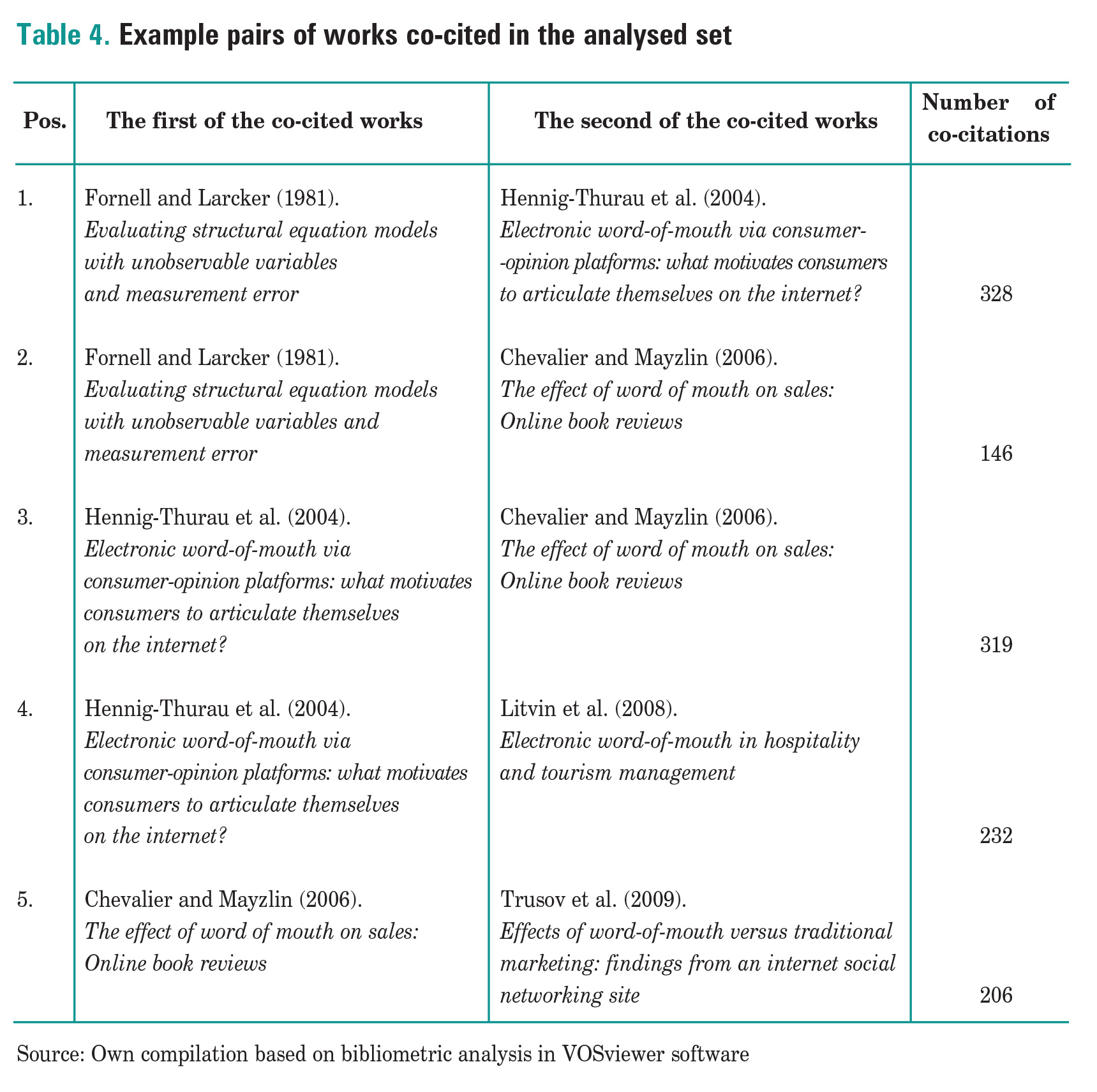
Summarisation
'Word of mouth’ as a communication tool has evolved quite significantly over the past few decades. Originally, the transmission of information by WOM was limited to local coverage i.e. it was restricted only to the closest people in the circle of the sender of the message. The sender was usually the consumer, treated as an impartial source of information. The technological developments that have taken place over the past 30 years, especially computer and mobile technologies, have caused significant changes in this form of communication. The information transmitted has acquired a global reach; the consumer can establish direct communication with the entrepreneur. Unfortunately, a revealing problem-and one that is becoming increasingly important for consumer protection-is the appearance of communications from unknown sources, which indicates a greater likelihood of insincerity and potential manipulation of consumer behaviour.
The objectives identified in the research methodology section resulted in the use of only data on publications and their authors as part of the citation and co-citation analysis. In the citation analysis, some of the measures related to the use of authors’ affiliations of papers and information related to their country of origin were omitted. On the other hand, in the case of co-citation analysis, for example, the places of publication of individual works were omitted. This does not change the fact that the collected information (Table 5) allowed the procurement of answers to the set objectives.
The first stated objective concerned the most frequently cited publications and their authors in the field of WOM. The most cited publication in the field of social sciences is the work of Chevalier and Mayzlin (2006). This is followed by the works of Van Doorn et al. (2010) and Dellarocas (2003). When the citations are restricted to the generated set of publications only, the ranking is as follows: Chevalier and Mayzlin (2006), Godes and Mayzlin (2004) and Liv (2006). It should be noted that the publications indicated were published relatively long ago and the youngest paper was published in 2016. This does not change the fact that the publications indicated on both lists form a list of works one should consult when studying the issue of WOM. The second objective indicated was to identify the publications most often referred to by authors writing papers on WOM. These are: Fornell and Larcker (1981), Hennig-Thurau et al. (2004) and Chevalier and Mayzlin (2006).

Endnotes
1 It should be noted that purely quantitative citation analysis has been widely criticised. It is based on the view that citations should not be treated equally (Zhang et al., 2013). In practice, citations may arise for various reasons and serve different functions (Zhang et al., 2013; Jha et al., 2017). Giving all citations equal value ignores the numerous potential functions they perform for the citing authors (Zhu et al., 2015).
2 The total link strength of a given node is the sum of the link strength of that node to all other nodes.
References
1. Abbas, A. F., Jusoh, A. B., Mas’od, A., & Ali, J. (2020). Bibliometric analysis of global research trends on electronic word of mouth using Scopus database. Journal of Critical Reviews, 7(16), 405–412.
2. Allport, G. W., & Postman, L. (1946). An analysis of rumor. Public Opinion Quarterly, 10(4), 501–517.
3. Anderson, M. H. (2006). How can we know what we think until we see what we said? A citation and citation context analysis of Karl Weick’s the social psychology of organizing. Organization Studies, 27(11), 1675–1692.
4. Anderson, J. C., & Gerbing, D. W. (1988). Structural equation modeling in practice: A review and recommended two-step approach. Psychological Bulletin, 103(3), 411.
5. Aria, M., & Cuccurullo, C. (2017). Bibliometrix: An R-tool for comprehensive science mapping analysis. Journal of Informetrics, 11(4), 959–975.
6. Bhaiswar, R., Meenakshi, N., & Chawla, D. (2021). Evolution of electronic word of mouth: A systematic literature review using bibliometric analysis of 20 years (2000–2020). FIIB Business Review, 10(3), 215–231.
7. Boyack, K., Klavans, R., & Börner, K. (2005). Mapping the backbone of science. Scientometrics, 64, 351–374.
8. Brodie, R. J., Ilic, A., Juric, B., & Hollebeek, L. (2013). Consumer engagement in a virtual brand community: An exploratory analysis. Journal of Business Research, 66(1), 105–114.
9. Brown, J. J., & Reingen, P. H. (1987). Social ties and word-of-mouth referral behavior. Journal of Consumer Research, 14, 350–362.
10. Buttle, F. A. (1998). Word of mouth: Understanding and managing referral marketing. Journal of Strategic Marketing, 6(3), 241–254.
11. Cesvet, B., Babinski, T., & Alper, E. (2010). Kapitał konwersacyjny: jak tworzyć rzeczy, o których inni będą chcieli rozmawiać. Oficyna a Wolters Kluwer Business.
12. Chevalier, J. A., & Mayzlin, D. (2006). The effect of word of mouth on sales: Online book reviews. Journal of Marketing Research, 43(3), 345–354.
13. Chu, S. C., & Kim, Y. (2011). Determinants of consumer engagement in electronic wordofmouth (eWOM) in social networking sites. International Journal of Advertising, 30(1), 47–75.
14. Cobo, M. J., López-Herrera, A. G., Herrera-Viedma, E., & Herrera, F. (2011). An approach for detecting, quantifying, and visualizing the evolution of a research field: A practical application to the Fuzzy Sets Theory field. Journal of Informetrics, 5(1), 146–166.
15. De Matos, C. A., & Rossi, C. A. V. (2008). Word-of-mouth communications in marketing: A meta-analytic review of the antecedents and moderators. Journal of the Academy of Marketing Science, 36, 578–596.
16. de Solla Price, D. J. (1965). Networks of scientific papers. Science, 149(3683), 510–515.
17. Dellarocas, C. (2003). The digitization of word of mouth: Promise and challenges of online feedback mechanisms. Management Science, 49(10), 1407–1424.
18. Donthu, N., Kumar, S., Mukherjee, D., Pandey, N., & Lim, W. M. (2021a). How to conduct a bibliometric analysis: An overview and guidelines. Journal of Business Research, 133, 285–296.
19. Donthu, N., Kumar, S., Pandey, N., Pandey, N., & Mishra, A. (2021b). Mapping the electronic word-of-mouth (eWOM) research: A systematic review and bibliometric analysis. Journal of Business Research, 135, 758–773.
20. Ejdys, J. (2016). Problematyka społecznej odpowiedzialności biznesu jako obiekt naukowych zainteresowań — wyniki analizy bibliometrycznej. Przegląd Organizacji, 4(915), 36–44.
21. Fornell, C., & Larcker, D. F. (1981). Evaluating structural equation models with unobservable variables and measurement error. Journal of Marketing Research, 18(1), 39–50.
22. Garfield, E. (1979). Is citation analysis a legitimate evaluation tool? Scientometrics, 1(4), 359–375.
23. Gawrońska, M. (2013). Marketing szeptany jako nowoczesna forma promocji. Rynek, Społeczeństwo, Kultura, 2(6), 30–35.
24. Godes, D., & Mayzlin, D. (2004). Using online conversations to study word-of-mouth communication. Marketing Science, 23(4), 545–560.
25. Hennig-Thurau, T., Gwinner, K. P., Walsh, G., & Gremler, D. D. (2004). Electronic word-of-mouth via consumer-opinion platforms: What motivates consumers to articulate themselves on the internet? Journal of Interactive Marketing, 18(1), 38–52.
26. Herr, P. M., Kardes, F. R., & Kim, J. (1991). Effects of word-of-mouth and productattribute information on persuasion: An accessibility-diagnosticity perspective. Journal of Consumer Research, 17(4), 454–462.
27. Huang, M., Cai, F., Tsang, A. S. L., & Zhou, N. (2011). Making your online voice loud: The critical role of WOM information. European Journal of Marketing, 45(7/8), 1277–1297.
28. Huete-Alcocer, N. (2017). A literature review of word of mouth and electronic word of mouth: Implications for consumer behavior. Frontiers in Psychology, 8:1256.
29. Jha, R., Jbara, A.-A., Qazvinian, V., & Radev, D. R. (2017). NLP-driven citation analysis for scientometrics. Natural Language Engineering, 23(1), 93–130.
30. Klincewicz, K., Mijal, M., & Żemigała, M. (2012). Bibliometria w zarządzaniu technologiami i badaniami naukowymi. Ministerstwo Nauki i Szkolnictwa Wyższego.
31. Kundu, S., & Rajan, C. R. (2016). Word of mouth: A literature review. International Journal of Economics and Management Sciences, 6, 467.
32. Lemon, K. N., & Verhoef, P. C. (2016). Understanding customer experience throughout the customer journey. Journal of Marketing, 80(6), 69–96.
33. Lenart-Gansiniec, R. (2021). Systematyczny przegląd literatury w naukach społecznych. Przewodnik dla studentów, doktorantów i nie tylko. Wydawnictwo Naukowe SCHOLAR, Warszawa, Poland.
34. Linkiewicz, A. (2015). Ewolucja marketingu szeptanego jako narzędzia komunikacji marketingowej w świetle rozwoju technologii informacyjnych. Prace Naukowe Uniwersytetu Ekonomicznego we Wrocławiu, 406, 346–357.
35. Litvin, S. W., Goldsmith, R. E., & Pan, B. (2008). Electronic word-of-mouth in hospitality and tourism management. Tourism Management, 29(3), 458–468.
36. Liu, Y. (2006). Word of mouth for movies: Its dynamics and impact on box office revenue. Journal of Marketing, 70(3), 74–89.
37. McCain, K. W. (1990). Mapping scholars in intellectual space: A technical overview. Journal of the American Society for Information Science, 41(6), 433–443.
38. Meuter, M. L., Ostrom, A. L., Roundtree, R. I., & Bitner, M. J. (2000). Self-service technologies: Understanding customer satisfaction with technology-based service encounters. Journal of Marketing, 64(3), 50–64.
39. Mudambi, S. M., & Schuff, D. (2010). Research note: What makes a helpful online review? A study of customer reviews on Amazon.com. MIS Quarterly, 34(1), 185–200.
40. O’Reilly, K., & Marx, S. (2011). How young, technical consumers assess online WOM credibility. Qualitative Market Research: An International Journal, 14 (4), 330–359.
41. Osareh, F. (1996). Bibliometrics, citation analysis and co-citation analysis: A review of literature I. Libri, 46(3), 227–225 149–158.
42. Podsakoff, P. M., MacKenzie, S. B., Lee, J. Y., & Podsakoff, N. P. (2003). Common method biases in behavioral research: A critical review of the literature and recommended remedies. Journal of Applied Psychology, 88(5), 879.
43. Richins, M. L. (1983). Negative word-of-mouth by dissatisfied consumers: A pilot study. Journal of Marketing, 47(1), 68–78.
44. Roemer, R. C., & Borchardt, R. (2015). Meaningful metrics: A 21st century librarian’s guide to bibliometrics, altmetrics, and research impact. American Library Association.
45. Small, H. (1973). Co-citation in the scientific literature: A new measure of the relationship between two documents. Journal of the American Society for Information Science, 24(4), 265–269.
46. Stokes, D., Syed, S. A., & Lomax, W. (2002). Shaping up word of mouth marketing strategy: The case of an independent health club. Journal of Research in Marketing and Entrepreneurship, 4(2), 119–133.
47. Sweeney, J., Soutar, G., & Mazzarol, T. (2014). Factors enhancing word-of-mouth influence: Positive and negative service-related messages. European Journal of Marketing, 48(1/2), 336–359.
48. Trusov, M., Bucklin, R. E., & Pauwels, K. (2009). Effects of word-of-mouth versus traditional marketing: Findings from an internet social networking site. Journal of Marketing, 73(5), 90–102.
49. Usdiken, B., & Pasadeos, Y. (1995). Organizational analysis in North-America and Europe — A comparison of co-citation networks. Organization Studies, 16(3), 503–526.
50. v. Wangenheim, F., & Bayón, T. (2004). The effect of word of mouth on services switching: Measurement and moderating variables. European Journal of Marketing, 38(9/10), 1173–1185.
51. Van Doorn, J., Lemon, K. N., Mittal, V., Nass, S., Pick, D., Pirner, P., & Verhoef, P. C. (2010). Customer engagement behavior: Theoretical foundations and research directions. Journal of Service Research, 13(3), 253–266.
52. Westbrook, R. A. (1987). Product/consumption — based affective responses and postpurchase processes. Journal of Marketing Research, 24(3), 258–270.
53. Zaraket, S. (2020). Consumer behaviour and social network sites: The impact of negative word of mouth. Routledge.
54. Zhang, G., Ding, Y., & Milojević, S. (2013). Citation content analysis (CCA): A framework for syntactic and semantic analysis of citation content. Journal of the American Society for Information Science and Technology, 64(7), 1490–1503.
55. Zhu, X., Turney, P., Lemire, D., & Vellino, A. (2015). Measuring academic influence: Not all citations are equal. Journal of the Association for Information Science and Technology, 66(2), 408–427.
56. Zhu, F., & Zhang (Michael), X. (2010). Impact of online consumer reviews on sales: The moderating role of product and consumer characteristics. Journal of Marketing, 74(2), 133–14.
57. Zupic, I., & Cater, T. (2015). Bibliometric methods in management and organization. Organizational Research Methods, 18(3), 429–472.
58. van Eck, N. J., Waltman, L. (2010). Software survey: VOSviewer, a computer program for bibliometric mapping. Scientometrics, 84(2), 523–538
Krzysztof Błoński — Associate professor at Marketing Department in the University of Szczecin, Poland. His research interests focus on marketing, consumer behaviour and the use of quantitative, qualitative and mixedmethod research in the area of management.

